
Harley-Davidson, Inc. is an American motorcycle manufacturer headquartered in Milwaukee, Wisconsin, United States. Founded in 1903, it is one of two major American motorcycle manufacturers to survive the Great Depression along with its historical rival, Indian Motorcycles. The company has survived numerous ownership arrangements, subsidiary arrangements, periods of poor economic health and product quality, and intense global competition to become one of the world's largest motorcycle manufacturers and an iconic brand widely known for its loyal following. There are owner clubs and events worldwide, as well as a company-sponsored, brand-focused museum.

A flat-twin engine is a two-cylinder internal combustion engine with the cylinders on opposite sides of the crankshaft. The most common type of flat-twin engine is the boxer-twin engine, where both pistons move inwards and outwards at the same time.
Buell Motorcycles is an American motorcycle manufacturer based in Grand Rapids, Michigan, United States. It was founded in 1983 by ex-Harley-Davidson engineer Erik Buell. Harley-Davidson acquired 49 percent of Buell in 1993, and Buell became a wholly owned subsidiary of Harley-Davidson by 2003. On November 17, 2006, Buell announced that it had produced and shipped its 100,000th motorcycle.
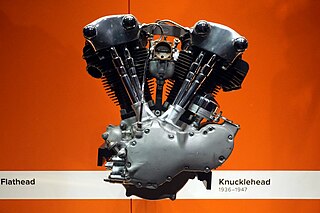
The knucklehead is a retronym used by enthusiasts to refer to a Harley-Davidson motorcycle engine, so named because of the distinct shape of the rocker boxes. The engine is a two-cylinder, 45 degree, pushrod actuated overhead valve V-twin engine with two valves per cylinder. It was the third basic type of V-Twin engine used by Harley-Davidson, replacing the Flathead-engined VL model in 1936 as HD's top-of-the-line model. The engine was manufactured until 1947 and was replaced by the Panhead engine in 1948. The Knucklehead-engined models were originally referred to as "OHVs" by enthusiasts of the time and in Harley's official literature; the nickname arose from the California chopper culture of the late 1960s.

The Panhead is an overhead-valve Harley-Davidson motorcycle engine, so nicknamed because the rocker covers resembled cooking pans. The engine is a two-cylinder, two-valve-per-cylinder, pushrod V-twin, made in both 61 c.i. (EL) and 74 c.i. displacements. The Panhead engine replaced the Knucklehead engine in 1948 and was manufactured until 1965 when it was replaced by the Shovelhead.
The Crocker Motorcycle Company is an American manufacturer, based in Los Angeles, California, founded by Albert Crocker. Located at 1346 Venice Blvd, Crocker produced a series of kits and whole motorcycles between 1931 and 1941: an overhead-valve conversion kit for the Indian 101 Scout motor (1932), a single-cylinder speedway racer (1934), powerful V-twin road motorcycles (1936–40), and the Scootabout (1940–41)motor scooter. Production ceased in 1941.

The Harley-Davidson Sportster is a line of motorcycles produced continuously since 1957 by Harley-Davidson. Sportster models are designated in Harley-Davidson's product code by beginning with "XL". In 1952, the predecessors to the Sportster, the Model K Sport and Sport Solo motorcycles, were introduced. These models K, KK, KH, and KHK of 1952 to 1956 had a sidevalve engine, whereas the later XL Sportster models use an overhead valve engine. The first Sportster in 1957 had many of the same features of the KH including the frame, fenders, large gas tank and front suspension.

The Evolution engine is an air-cooled, 45-degree, V-twin engine manufactured from 1984 by Harley-Davidson for the company's motorcycles. It was made in the 1,340 cc (82 cu in) displacement for Harley-Davidson Big V-twins bikes, replacing the Shovelhead engine until 2000 when the last EVO was placed in a production factory custom FXR4. In 1999, it was replaced by the Harley-Davidson Twin Cam 88 in the Touring and Dyna model and in 2000 in the Softail models. Also available in the Sportster model beginning in 1986, it was made in the 1,100 cc (67 cu in) displacement until 1988 and is still made in the 883 cc (53.9 cu in) and 1,200 cc (73 cu in) displacements for the Harley-Davidson Sportster, replacing the ironhead Sportster engine.

The Harley-Davidson Twin Cam are motorcycle engines made by Harley-Davidson from 1998 to 2017. Although these engines differed significantly from the Evolution engine, which in turn was derived from the series of single camshaft, overhead valve motors that were first released in 1936, they share a number of characteristics with nearly all previous Harley-Davidson engines. Both engines have two cylinders in a V-twin configuration at 45°, are air-cooled, and activate valves with push-rods. The crankshafts have a single pin with a knife and fork arrangement for the connecting rods. These are sandwiched between a pair of flywheels.
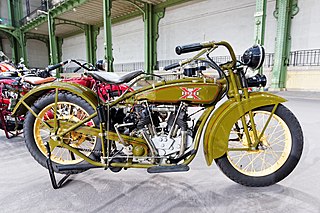
The Excelsior Super X was a motorcycle manufactured by the Excelsior Motor Manufacturing & Supply Company from 1925 to 1931. It was the most famous Excelsior motorcycle manufactured by that company and was the first American forty-five cubic inch motorcycle.

The Harley-Davidson XA was a flat-twin, shaft drive motorcycle made by Harley-Davidson for the US Army during World War II.
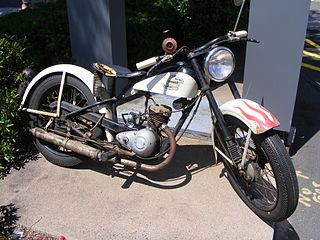
The Hummer was a motorcycle model manufactured by Harley-Davidson from 1955 to 1959. However, the name "Hummer" is now incorrectly used generically to refer to all American-made single-cylinder two-stroke Harley-Davidson motorcycles manufactured from 1948 to 1966. These motorcycles were based on the DKW RT125, the drawings for which were taken from Germany as war reparations after World War II. The RT125 drawings were also given to the United Kingdom and the Soviet Union as war reparations, resulting in the BSA Bantam and the MMZ M-1A Moskva, later known as the Minsk.
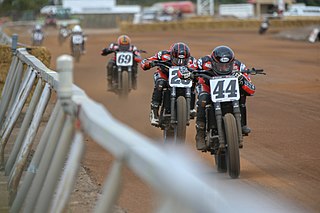
American Flat Track is an American motorcycle racing series. The racing series, founded and sanctioned by the American Motorcyclist Association (AMA) in 1954, originally encompassed five distinct forms of competitions including mile dirt track races, half-mile, short-track, TT steeplechase and road races. The championship was the premier motorcycle racing series in the United States from the 1950s up until the late 1970s.

The Cleveland Motorcycle Manufacturing Company, sometimes called Cleveland Motorcycle, was a motorcycle manufacturer in Cleveland, Ohio, from 1902 to 1905 and again from 1915 to 1929.

The Harley-Davidson Model W, also known as the Sport Twin, is a motorcycle made by Harley-Davidson from 1919 to 1923. Unusually for a Harley-Davidson motorcycle, the Model W had a flat-twin engine and a trailing link fork. The Model W set speed records on runs from New York City to Chicago and from the Canada–United States border to the Mexico–United States border. Slow home market sales led to the end of production after four years.
The Indian Prince is a motorcycle manufactured by the Hendee Manufacturing Company from 1925 to 1928. An entry-level single-cylinder motorcycle, the Prince was restyled after its first year and discontinued after four years.
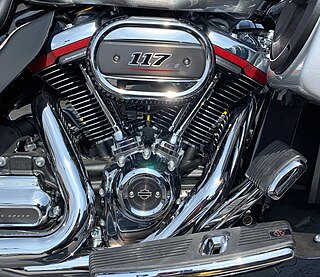
The Harley-Davidson Milwaukee-Eight engine is the ninth generation of "big twin" engines developed by the company, but only Harley's fourth all-new Big Twin in 80 years, first introduced in 2016. These engines differ from the traditional Harley Big Twin engines in that there are four valves per cylinder, totaling eight valves, hence the name. It also marked a return to the single-camshaft configuration as used on previous Harley Big Twin Engines from 1936 to 1999. In addition, the engines all have internal counterbalancers, whereas Twin Cams were counterbalanced only on Softail models, where the engine was rigidly mounted.

The Harley-Davidson Fat Boy, is a V-twin softail cruiser motorcycle with solid-cast disc wheels. Designed by Willie G. Davidson and Louie Netz, Harley-Davidson built a prototype Fat Boy in Milwaukee for the Daytona Bike Week rally at Daytona Beach in 1988 and 1989. Fat Boys produced from 1990 to 2017 are coded FLSTF, and FLFB from 2018.
The single cylinder engine had been a mainstay of the Harley-Davidson line since the early days of the company's founding in 1903, but it was not until 1909 that the V-twin design was added. It was Introduced in 1926, and it disappeared from the program in 1934 and was reintroduced in 1937 as Harley-Davidson V - Twin B.
















